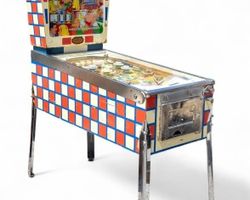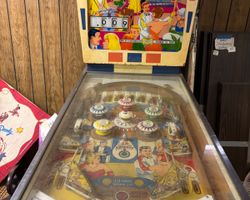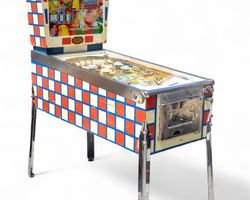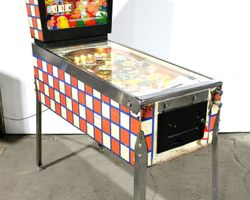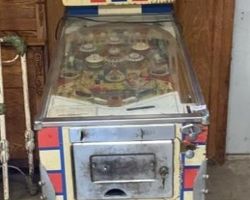Sky Line
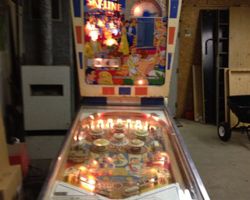
Average Prices: USD $400 to $900
Produced: January, 1965
Production Run: 2,000 units
Machine Type: Electro-mechanical
Players: 1
Design by: Wayne Neyens
Art by: Roy Parker
The pinball machine "Sky Line," released by D. Gottlieb & Co. in January 1965, represents a distinctive chapter in the electro-mechanical era of pinball. With a production run of 2,000 units, this single-player machine, model number 210, invited players on a vertical journey through a vibrant cityscape, evoking the allure of high-rise nightclubs and elegant nightlife. The conceptualization, design, animation, and mechanics of "Sky Line" were primarily the work of Wayne Neyens, a prolific designer whose contributions shaped many Gottlieb machines of the period. The captivating visual identity, a hallmark of Gottlieb productions, was brought to life by artist Roy Parker, whose work is central to "Sky Line's" enduring appeal.
The creation of "Sky Line" unfolded during a period where manufacturers experimented with engaging themes and novel mechanical features to distinguish their offerings. Wayne Neyens, leveraging his deep understanding of pinball mechanics and player psychology, conceived a game centered on an elevator motif, a distinct departure from more common sports or fantasy themes. Roy Parker’s artistic interpretation transformed this concept into a visually rich experience. Early sample machines of "Sky Line" featured a green elevator door in the backglass, accompanied by a design of a top hat, glove, and cane, and utilized older daisy-style pop bumper caps. However, production models transitioned to blue elevator doors, removing the additional design above them, and incorporated Gottlieb's newer starburst bumper caps. These subtle yet noticeable changes distinguish early samples from the more widely distributed production units, providing interesting insight into the final aesthetic choices made for the machine.
Signature Features and Design
"Sky Line" is defined by its integrated theme, brought to life through both its playfield and, notably, its backglass. The machine's primary mechanical features include two flippers, five pop bumpers, two slingshots, and two standup targets. Dual outlanes flank the playfield, demanding player control. What truly elevates "Sky Line's" design, however, are its unique backbox animations. The backglass houses two dynamic elements: a pair of elevator doors that visually open and close, and an elevator floor arrow that progresses, counting floors achieved during gameplay. These animations are not merely decorative; they directly tie into the game's progression and visual storytelling, providing a tangible sense of advancement as players rack up points and achieve objectives.
Roy Parker’s artwork for "Sky Line" is a standout element, frequently cited as one of the machine's strongest attributes. The playfield and backglass are adorned with lavish, colorful depictions of a ritzy, metropolitan environment. Parker’s use of vibrant hues and detailed imagery transports players to a "golden age" of sophisticated nightlife, with characters in elegant attire set against a backdrop of towering buildings. This artistic direction creates a cohesive and immersive atmosphere, enhancing the overall experience beyond the mechanical play itself. The visual presentation of "Sky Line" captures a sense of charm and beauty, contributing significantly to its identity.
Playfield and Mechanics
The playfield layout of "Sky Line" is designed to encourage exploration and precision, despite its seemingly straightforward appearance. At the top of the playfield lies a distinctive clock-shaped target, integral to the game's scoring and objective system. Below this, a series of 1-12 number rollover targets are strategically placed, forming the core objective of lighting all numbers to trigger special features.
Central to the playfield is a multi-bumper area, comprising five pop bumpers. While four of these are active, a static bumper is positioned in the center, influencing ball movement within this cluster. This design choice directs the ball's trajectory, requiring players to aim for specific contacts within the bumper area to score points or activate number rollovers. Two slingshots sit above the flippers, providing reactive kick-outs that can redirect the ball unexpectedly. Additionally, two standup targets offer direct scoring opportunities. The flow of the playfield encourages players to navigate the ball through the rollover lanes to light numbers, and then guide it into the multi-bumper zone or towards other targets to advance the elevator and accumulate points. The design philosophy behind this layout aims for accessibility, allowing casual players to enjoy the immediate satisfaction of hitting targets, while offering enough depth for more experienced players to develop shot strategies. The artwork, vibrant and detailed, ties directly into the playfield elements, from the numbered rollovers to the themed targets, creating a unified aesthetic experience under the typical incandescent lighting of the era.
Gameplay Dynamics
"Sky Line's" gameplay mechanics are rooted in the pursuit of two primary objectives: collecting all twelve numbers to light a special, and advancing the elevator’s floor count for replays. At the start of each game, all numbers from 1 to 12 are lit on the playfield, and the backglass elevator arrow resets to zero. Hitting a lit number, either via a rollover lane or through interactions with the multi-bumper area, scores that number and visually registers it on the playfield and often the backglass.
Once all twelve numbers are collected, a "Special" feature is lit on one of the numbers, chosen randomly. This roving special changes its location each time a 1-point value is scored, encouraging players to carefully aim or strategically nudge the machine to catch the special for an awarded replay. This "Special" remains lit for the duration of the game, offering opportunities for multiple replays within a single credit. Further replay opportunities are tied to the elevator’s floor count. Hitting a designated "advance" target when lit progresses the elevator arrow on the backglass to the next floor. Reaching higher floors awards replays, with the specific floor thresholds being operator-selectable, allowing for difficulty adjustments. Scoring in "Sky Line" is straightforward, primarily offering 1, 10, or 20 points for various contacts. The maximum displayed point score is 1,999 points. The sound design is minimalist, typical for an electro-mechanical machine, featuring two bells and a knocker for replays. However, the mechanical sounds of the elevator doors opening and the floor indicator moving, along with the score motor, add a layer of thematic immersion beyond basic scoring sounds. Player strategy often involves prioritizing the collection of numbers while also attempting to skillfully direct the ball towards the "advance" targets to progress the elevator. The multi-bumper area, while dynamic, requires precise hits to activate specific contacts for number collection.
Reception and Legacy
"Sky Line" holds a respected position within the pinball community, generally receiving positive feedback for its distinct qualities. Its primary strengths are consistently identified as its stunning artwork, a testament to Roy Parker’s skill, which is often described as beautiful, colorful, and lavish. The unique elevator theme is also a significant draw, contributing to the machine’s charm and identity. The dual backglass animations—the opening elevator doors and the moving floor indicator—are particularly highlighted as exceptional features that enhance the gameplay experience and are a major attraction for many enthusiasts. The game is often appreciated for its player-friendly flipper gap, which is shorter than some contemporary machines, potentially allowing for more flipper saves and extended ball times. Many players report experiencing the "one more game" feeling, indicating an addictive quality.
However, "Sky Line" is not without its points of contention. The multi-bumper area, while a focal point for action, draws mixed reactions due to the presence of a static "dead" bumper in its center. Some players feel this design choice can reduce the expected rapid-fire action of a traditional bumper cluster, leading to fewer "thumps for your money" and requiring overly precise hits to register specific contacts. The rules, while accessible, are considered simple by some, leading to a perception that the game may lack the long-term challenge or deeper strategic layers found in other classic titles. Additionally, the side outlanes are noted by some as being wider and more prone to drains, particularly when slingshots activate or during nudging. The progression of elevator levels is also sometimes perceived as more luck-based than skill-based.
Despite these criticisms, "Sky Line" maintains a positive reputation as a charming classic Gottlieb wedgehead. Its influence lies in its successful integration of a novel theme with engaging backglass animations, a design approach that Gottlieb continued to refine in subsequent machines. "Sky Line" stands as an example of the era's focus on creating visually appealing and thematically cohesive pinball experiences, contributing to the rich tapestry of electro-mechanical pinball history.
Sponsored Links
 Ebay Listings
Ebay Listings
 Auction Results
Auction Results
| Cost | Location | Date |
|---|---|---|
| USD $400 |  United States United States |
24 August, 2025 |
| USD $550 |  Pennsylvania, United States Pennsylvania, United States |
14 June, 2025 |
| USD $550 |  Pennsylvania, United States Pennsylvania, United States |
14 June, 2025 |
| USD $316 |  Georgia, United States Georgia, United States |
07 October, 2024 |
| USD $1,175 |  Pennsylvania, United States Pennsylvania, United States |
18 May, 2023 |
| USD $190 |  Pennsylvania, United States Pennsylvania, United States |
07 December, 2022 |
| USD $1,300 |  Massachusetts, United States Massachusetts, United States |
05 June, 2022 |
| USD $750 |  Maryland, United States Maryland, United States |
26 February, 2021 |
| USD $520 |  Minnesota, United States Minnesota, United States |
05 April, 2020 |
| USD $500 |  Missouri, United States Missouri, United States |
03 May, 2018 |


Private Policy · Search Website · Contact Us
As an eBay Partner, we may earn a commission from qualifying purchases made through links on this site, at no additional cost to you.
All trademarks and copyrighted materials remain property of their respective owners. All other content copyright 2007 - 2025 Pinpedia.

